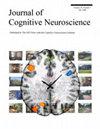Temporal Dynamics and Representational Consequences of the Control of Processing Conflict between Visual Working Memory and Visual Perception
IF 3
3区 医学
Q2 NEUROSCIENCES
引用次数: 0
Abstract
Visual working memory (WM) extensively interacts with visual perception. When information between the two processes is in conflict, cognitive control can be recruited to effectively mitigate the resultant interference. The current study investigated the neural bases of the control of conflict between visual WM and visual perception. We recorded the EEG from 25 human participants (13 male) performing a dual task combining visual WM and tilt discrimination, the latter occurring during the WM delay. The congruity in orientation between the memorandum and the discriminandum was manipulated. Behavioral data were fitted to a reinforcement-learning model of cognitive control to derive trial-wise estimates of demand for preparatory and reflexive control, which were then used for EEG analyses. The level of preparatory control was associated with sustained frontal-midline theta activity preceding trial onset, as well as with the strength of the neural representation of the memorandum. Subsequently, discriminandum onset triggered a control prediction error signal that was reflected in a left frontal positivity. On trials when an incongruent discriminandum was not expected, reflexive control that scaled with the prediction error acted to suppress the neural representation of the discriminandum, producing below-baseline decoding of the discriminandum that, in turn, exerted a repulsive serial bias on WM recall on the subsequent trial. These results illustrate the flexible recruitment of two modes of control and how their dynamic interplay acts to mitigate interference between simultaneously processed perceptual and mnemonic representations.控制视觉工作记忆和视觉感知之间处理冲突的时间动态和表征后果。
视觉工作记忆(WM)与视觉知觉有广泛的相互作用。当两个过程之间的信息冲突时,认知控制可以有效地减轻由此产生的干扰。本研究探讨了视觉知觉与视觉知觉冲突控制的神经基础。我们记录了25名参与者(13名男性)的脑电图(EEG),他们执行了视觉WM和倾斜识别的双重任务,后者发生在WM延迟期间。备忘录与歧视的取向一致性被操纵。行为数据被拟合到认知控制的强化学习模型中,以获得对预备控制和反身控制需求的试验估计,然后将其用于脑电图分析。预备控制水平与试验开始前持续的额中线θ活动有关,也与备忘录的神经表征强度有关。随后,判别性发作触发了一个控制预测错误信号,反映在左额叶阳性上。在试验中,当不一致的判别不被预期时,与预测误差相对应的反射性控制抑制了判别的神经表征,产生了低于基线的判别解码,反过来,在随后的试验中,对WM回忆施加了排斥的序列偏差。这些结果说明了两种控制模式的灵活招募,以及它们的动态相互作用如何减轻同时处理的知觉表征和助记表征之间的干扰。
本文章由计算机程序翻译,如有差异,请以英文原文为准。
求助全文
约1分钟内获得全文
求助全文
来源期刊
CiteScore
5.30
自引率
3.10%
发文量
151
审稿时长
3-8 weeks
期刊介绍:
Journal of Cognitive Neuroscience investigates brain–behavior interaction and promotes lively interchange among the mind sciences.

 求助内容:
求助内容: 应助结果提醒方式:
应助结果提醒方式:


